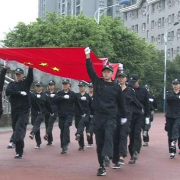新目标七年级上册英语教案(英语七年级上册的主要词组与句型)
来源:择校网 时间:2025-02-26 16:31:15
一、新目标***人教版***英语七年级上册的主要词组与句型
第一册词组(共26个)
1.in English用英语
2.how many多少
3.a piece of bread一片而包
4.four cups of tea四杯茶
5.a pair of shoes一双鞋
6.play chess下棋
7.run after追逐
8.play football踢足球
9.be good at擅长
10.on the basketabll team在篮球队
11.scoot at the basket投篮
12.the first us第一班车
13.at eight在八点
14.hurry up快点
15.a quarter past ten十点一刻
16.five to eleven差五分十一点
17.the next train下一趟火车
18.on Monday在周一
19.a ticket for Shanghai一张飞往上海的机票
20.at home在家
21.a good idea好主意
22.go skating去滑冰
23.in the afternoon在下午
24.in winter在冬季
25.make a snowman堆雪人
26. put on穿上,戴上
第二册词组(共84个)
1.in Class One,Grade One在一年级一班
2.play ball games进行球类活动
3.read books读书
4.in summer在夏季
5.have one's class上课
6.on the playground在操场上
7.every day每天
8.the first class第一节课
9.be interested in对…感兴趣
10.his friend他的朋友
11.go to the zoo去动物园
12.collet stamps集邮
13.make model cars制作汽车模型
14.take pictures照相
15.grow roses种植玫瑰
16. go fishing去钓鱼
17.Chinese food中国食物
18.my parents我的父母
19.two American boys两个美国男孩
20.a new student一名新生
21.study English学英语
22.thank you谢谢
23.in China在中国
24.speak Japanese讲日语
25.very well很好
26.only a little只有一点
27.a department store百货商店
28.of course当然可以
29.try on试穿
30.have a look at看一看
31.how much多少钱
32.at the market在市场里
33.do shopping买东西
34.a post office邮局
35.deliver letters送信
36.take care of照顾
37.run a machine开机器
33.get up起床
39.last year去年
40.for a long time很长时间
41.next year明年
42.come back回来
43.listen to music听音乐
44.around the house在房子周围
45.have a party开聚会
46.have meals吃饭
47.look for寻找
48.the first floor第一层
49,each of us我们每个人
50.on the wall在墙上
51.be far from离……远
52.write to给……写信
53.get up起床
54.have breakfast(lunch, dinner, supper)吃早饭(午饭,晚饭)
55.do one’s homework做作业
56. go to bed上床睡觉
57.watch TV看电视
58.get to到达
59.at home在家
60. prepare for准备
6I.wake up叫醒 come in进来
62.go into进入
63.take a shower洗澡
64.comb one's hair梳头
65.brush one's teeth刷牙
66.say goodbye to和……说再见 at night在夜里
67.put on穿上,戴上
68.take off脱下,摘下
69.good night晚安
70.wash hands洗手
71.take a trip旅游
72.in front of在前面
73.in the east(south, west, north)在东边
74.by boat乘船
75.in the middle在中部
76.a map of China一张中国地图
77.how about怎么样
78.walk through走过
79.go down the street沿着这条街走
80.excuse me请原谅
81.at the end在终点
82.turn left(right)向左(右)转
83.want to do sth.想要做某事
84.next to旁边,隔壁
第三册词组[共72个)
1.at the party在聚会上
2.in a low voice低声的
3.give sb sth or give sth to sb给某人某物
4.enjoy oneseIf玩很高兴
5.have a party聚会
6.make friends with sb和某人交朋友
7.each other相互
8.think of认为
9.a lot of许多
10.enjoy doing sth.喜欢做某事
11.do morning exercise做早操
12.a good rest好好休息
13. go for a walk去散步
14.lie in bed躺在床上
15.plenty of大量的
16.catch a cold感冒
17.have a rest休息
18.three times a day一天三次
19.have a fever发烧
20.take the medicine吃药
21.be all right身体好了
22.one…the other一个,另一个
23.be on演出
24.be over结束
25.yesterday evening昨天晚上
26.It's good(bad) for…对…有好处(坏处)
27.once a week每周一次
28.turn on打开
29.turen off关上
30.nearly every day几乎每一天
31.all kinds of各种各样
32.at the bus stop在公共汽车站
33.get on上车
34.get off下车
35.wait for等待某人
36.show sb.round带领某人参观某地
37.be busy doing sth.忙于做某事
38.traffic lights交通灯
39.move on继续前进
40.be ready for为…做准备
41.slow down减慢速度
42.zebra crossing人行道
43.knock...off...撞倒
44.traffic rules交通法规
45.road signs交通标志
46.rush hours高峰期
47.go sightseeing去观光
48.be air, by plane乘飞机
49.by sea, by ship乘船
50.a few几个,—些
51.most of绝大多数
52.decide to do sth.决定做某事
53.had better最好
54.from…to...从…到…
55.ask sb to do sth.要求某人做某事
56.promise sb. to do sth.答应某人做某事
57.make a call打电话
58.take a message for sb.给某人捎个信
59. pick up捡起,拾起
60.cut off切断
61.put down放下
62.go camping去野营
63.hold on稍等
64.have a good time玩得高兴
65.at this moment现在
66.a telephone booth电话亭
67.have to不得不
68.send sb.sth., send sten. to sb.送给某人某物
69. pay for付款
70.in the middle在中间
71.You're welcome不客气
72.NO PARKING禁止停车
第四册词组(共118个)
1.be born出生于
2.visit sb拜访某人
3.tell sb. sth.告诉某人某事 tell sb.to do sth.告诉某人做某事
4.tell sb.not to do sth.告诉某人不要做某事
a)teII sb.how to do sht告诉某人怎样做某事
b)go to a place to do sth去某个地方做某事
c)go to England to study English去英国学习英语
5.study at a middle school在中学学习
6. go boating去划船 go fishing去钓鱼
7.go swimming去游泳 go shopping去购物 go skating去滑冰
8.at weekends在周末
9.at the age of在……年龄
10.come here at half past two every Saturday afternoon每个星期六下午两点半来这儿
11.take pictures照相
12.in one’s spare time在业余时间
13.come here to do sth.来这儿做某事
14.come in进来
15.sit down坐下 stand up起立
16.ask sb. some questions询问某人一些问题
17.on May 2,1984在1984年5月2日
18.tell sb. the name of the street and the house number告诉某人街道名字和房间号码
19.like doing sth.喜欢做某事 like to do sth.喜欢做某事
20.become a teacher成为一名教师 want to be a doctor想成为一名教师
21.return to China=come back to China返回中国
22.teach English at a famous medical college在一所著名的医科大学教英语
23.tall and healthy个高又健康
24.short and slim个矮又苗条
25.be clever and quick in doing things在做事上聪明伶俐
26.come here to learn singing来这儿学唱歌
27.tell sb.a funny story给某人讲述有趣的故事
28.on foot步行
a)on one’s way to school在上学的路上
b)on one’s way home在回家的路上
c)on one’s way to the hospital在去医院的路上
d)on one’s way to the cinema在去电影院的路上
e)on one’s way to see a film在去看电影的路上
29.see sb. do sth.看见某人做某莫事 see sb.doing sth.看见某人正在做某事
a)hear sb. do sth听到某人做某事 hear sb. doing sth.听到某人正在做某事
b)make sb.do sth迫使某人做某事 help sb.(to) do sth.帮助某人做某事
c)1et sb.do sth.让某人做某事 had better do sth.最好做某事
30. fall to the ground倒在地上
31.go over走过去,复习功课
32. hurry to school勿忙去上学
33.be late for the first class第一节课迟到
34.say with a smile微笑地说
35.be glad to do sth.高兴做某事
36.do a good thing(deed)做一件好事
37.fall ill=be i11生病,患病
38.take sb. to a hospital把某人送到医院
39.rain heavily下大雨
40.on the road在公路上
41.not know what to do不知道该做什么
42.just then正在那时
43.come up走进,上来
44.in front of在……前面
45.thank sb. again and again反复感谢某人
46.drive away(汽车)离开
run away跑开
take away拿走
47.right away立刻
48.right now此刻,刚才,现在
49.get home到家 get there到达哪儿 get here到达这儿
50. yesterday morning昨天晚上
51.leave the hospital离开医院
52.no buses=not any buses没有车
53.say to sb.对某人说 say to oneself自言自语
54.fall off跌落
55.need to get up early需要早起床
56.hurt my arm胳膊受伤
57.What's wrong with you=What's the matter with you你怎么了
58.do one's homework on the computer在电脑上做作业
59.have four English lessons上四节英语课
60.once a week一周一次 twice a year一年两次 three times a month一个月三次
61.do more listening and speaking做大量的听说练习
do some cleaning扫除
do some washing洗衣服
do some shopping购物
62.make good progress in English在英语方面取得很大进步
63.help a lot in our studies在学习上给子很大帮助
64.teach sb. English教某人英语
65.get to school到达学校
66.give sb.lessons给某人上课
67.ask sb.to do sth.要求某人做某事
ask sb.not to do sth.要求某人不要做某事
68.let sb. do sth.让某人做某事
1et sb. not do sth.让某人不要做某事
69.not……until直到……才
70.make one's lessons interesting使某人的课上的很有趣
71.tell sb. how to do sth.告诉某人怎样做某事
72.try to learn new things be oneself设法靠自己学一些新的知识
73.want to be a history teacher想成为一名历史老师
74.grow up长大
75.in future在将来
76.computer room(电脑)机房
77.language lab语言室
78.finish middle school中学毕业
79.want to become(be) a designer想成为一名设计家
80.wish to be doctor希望成为一名医生
81.an American boy一个美国男孩儿
82.study in a high school在高中学习
83.in Grade Eight在八年级
84.finish primary school小学毕业
85.start school at the age of seven
=begin to school when I was seven七岁开始上学
86.move to Washington with his family和他全家搬到华盛顿
87.be interested in对……感兴趣
88.want to become a doctor of Chinese medicine想成为一名中医
89.come here to learn Chinese来这儿学习中文
90.a nice school一所好的学校
91.instead of代替
92.in many ways在许多方面
93.be different from与……不同
94.by the way顺便说
95.come back home回家
96.be sorry for为…难过,遗憾
97.feel sorry for为…难过,遗憾
98.burn away燃烧没了
99.open the door开门
100.take sb. in one's arms拥抱某人
101.have some medicine吃药
102.have a football match进行一场足球比赛
103.have a meeting开会
104.walk back向后走
105.give sth. back to sb.把某物还给某人
106. work through the night通宵工作
107.get through the examinations=pass the exam通过考试
108.happen to发生
l09.knock at the door敲门
110.want to do sth.想做…
111.fall down掉下来
112.begin to do sth.开始做…
113.have some tea喝茶
114.have sports进行体育锻炼
115.have a bad coId得了重感冒
116.have a good time玩的很高兴
117.keep back向后退
118.so…that如此…以至于…
第五册词组t共372个〕
1.near the fireplace在火炉旁
2.sit down坐下
3.jump up跳起来
4.be angry with sb.跟某人生气
5.get into the room through the window从窗户进入房间
6.have lessons上课
7.have to必须,不得不
8.be wet through全部湿透
9.on one's back在某人的背上
10.read through the newspaper通读报纸
11.be cold and hungry又冷又饿
12.next morning第二天早晨
13.make sth. for sb.为某人做…
14.buy sth. for sb.为某人买东西
15.help sb.with sth.在某方面帮助某人 help sb.(to) do sth.帮助某人做某事
16.run out of the house跑出房间
17.keep sth.保留东西
18.keep oneself clean保持个人卫生
19.a bit cheapcr便宜一点儿
20.hand sth.to sb.把某物递给某人.hand in sth.to sb.上交某人某物
21.put up one's hand举手
22.put on穿上 take off脱下
23.jump up跳起
24.be ready to do sth淮备做某事
25.all kinds of各种各样
26.show sb. sth.向某人展示某事
27.begin to do sth.开始做某事
28.make…from用……制作
29.be back soon一会儿就回来
30.in one's hand在手里
31. again and again一次又一次
32.wait a moment等一会
33.have no money没钱
34.come back withouu the coat没有穿衣服回来
35.understand his kind father理解他好心的父亲
36.be afraid害怕
37.a map of Beijing(China, the world)一张北京地图
38.at the end of this class这节课结束
39.Sorry to trouble you.对不起给你找麻烦了。
40.No trouble at all.没有一点儿麻烦。
41.football team足球队
42.play against对赛
43.a good player一名好远动员
44.be very exciting令人兴奋的
45.the first half of the match上半场,前半场
46.pass sth. to sb把某物递给某人
47.run very fast跑的很快
48.get into the goal(把球)射进球门
49.be very excited(人)感到兴奋
50.the result of the match比赛结果
51.invite sb. to a big dinner邀请某人就餐
52.near the end of the match比赛快要结束
53.catch the ball接住球
54. pass the hospital路过医院
55.pass sb.sth.把某物递给某人
56.pass the maths exam数学考试及格
57.a famous play著名戏剧
58. put on a short play上映短剧
59. get longer and longer天变得越来越长
60. get dark天黑
61.get some letters from my friends收到朋友的来信
62. get the news得到消息
63. get to the station到达车站
64.get home到家 get there到达哪儿
65.have got有
66.get on well with sb.和某人相处的很好
67.the right answers正确答案
68.both her parents她的父母双方
69.both of them他们中两个人
70.on both sides of the street在马路两旁
71.in both hands在双手里用双手
72.move over to the table到桌前就餐
73.prepare so much delicious food准备很多丰盛食物
74.help oneself to sth.自便,随便吃
75.a team from a country school一支来自农村的球队(运动员)
76.1ook like看起来像
77.one of the boys男孩中一个
78.a boy in a dirty T-shirt一个穿着脏T恤衫的男孩
79.stop the passs阻止传球
80.turn to shoot转过来投球
81.get two more points又得了两分
82.in a minute过了一会儿
83.be all over全场结束
84.a little better好一点儿
85.learn a more important lesson上了一节更重要的课
86.stay in bed for another two days再跟床上呆两天
87.one by one一个一个
88.about school life in England关于英国学校生活
89.wear a new dress at the party在聚会(上)穿一条新裙子
90.work by day and study by night(在)白天工作晚上学习
9t.by this time tomorrow不迟于明天这个时间
92.fly from Beijing to New York从北京飞到纽约
93.go to school from Monday to Friday从周一到周五上学
94.three weeks from today今天算起还有三个星期
95.live far away from the school住在离学校很远的地方
96. come from=be from来自于
97.get a letter from my friend收到我的朋友一封信
98. like some more fish喜欢再吃一些鱼
99. thank sb. for…为…而感谢某人
100.go to the hill with sth.带着东西上山
101.come to the top of the hill来到山顶
101. stay here呆在这儿
102.a good place一个好地方
103.go faster and faster走得越来越快
105.more and more children越来越多的孩子
106.come along=come with sb.跟上来
107.race down the hill比赛跑到山下
108.skate on the lake在湖上滑冰
109.come on跟(某人)来快点、加油
110.put sth. under the tree把某物放在树下
111.just then正在那时
112.come off脱离开
113.go off走开
114. a good lake for skating适合滑冰的湖
115.be ready for=get ready for prepare for为…做准备
116.run back up the hill跑回到山上
117.look out= be careful当心,小心
118.go over复习功课,走过去
119.run down the hill跑下山
120.go on skating over the lake在湖上继续滑冰
121.go round and round一圈一圈的走
122.come back to sb.返回到某人处
123.come up to sb.向某人那里走来
124.as…as与…一样
125.so…that如此…以至
126.too…to太…以至于不能…
127.on Friday afternoon在星期五下午
128.turn right向右拐
129.and so on等等
130.need a lot of things需要很多东西
131.It's time for sth.(for n)=It's time to do sth.该…时间了
132.study hard to get ready for努力学习为…作准备
133.study hard at English努力学习英语
134.stop sth.停止某事拦住某物
135.stop to do sth.停下来再做某事
136.stop doing sth.停止做某事
137.not at a11一点都不
133.stop sb. from doing sth.阻止某人做某事
139.wait for sth.(sb)等(车,人)
140.several people几个人
141.go back home on foot步行(返)回到家
142.go into the room quietly静静的走进屋
143.become a doctor成为一名医生
144.finish sth.完成某事 finish doing sth.做完某事
145.at about seven this morning今天早晨大约七点钟
146.half an hour半小时
147.an hour and a half一个半小时
148.play football踢足球
149.p1ay the piano弹钢琴
150.pass…on把…传递给
151.fall into the lake跌入湖中
152.aIl the children所有的孩子们
153.go round the lake围绕这湖走
154.look for寻找
155.call again and again(再三)反复叫喊
156. go out to walk on the thin ice出去在薄冰上走
157.as well as除…之外
158.get to the road到达公路
159.call out to sb.对某人大声的叫喊
160. get sb. out把某人救出来
161.try to do sth.尽力做某事
162.get a long ladder拿来一架长梯子
163.run along the road沿着马路跑
164.a big house一间大的房子
165. go into the house走进那间房子
166.come out with sth.拿着某物出来
167.hurry up赶紧
168.go back to the lake with sth.拿着某物返回到湖边
169. put the ladder down把梯子放倒
170.look round向四周看
171. go slowly along the ladder沿着梯子缓慢的爬行
172.in the hole在洞里
173.as soon as一...就...
174.wet through全湿透了
175. get hold of the ladder抓住梯子
176.start pulling sth. back开始住回拉
177.go home回家
178.be late for晚了,迟到
179. get slowly off the ladder从梯子上缓慢的下来
180.help each other互相帮助
181.heIp sb.a lot in learning English在英语学习方面帮助某人很多
182.carry these boxes into the classroom把这些箱子搬运到教室里
183.clearn the classroom打扫教室
184.look at the colorful lights over your head看你头上的彩灯
185.fly over the mountain飞越过山顶
186.all over the world遍及世界
187.over one hundred people一百多人
188.rush out of the classroom冲出教室
189.plant many trees round the school围绕学校种了许多树
190.look after照顾
191. look at看
192.look out of the window向窗外看
193.look worried看上去很焦急
194.look up the word in the dictionary查字典
195.develop into a modern city发展成一个现代化城市
196.in the centre of Beijing在北京市中心
197.in the past在过去
198. declare the founding of the new China宣布新中国成立
199.have a wonderful view of the city拥有—个美丽的城市风景
200.stand on top of the hill站在山顶
201. 7,300 seven thousand and three hundred
202.4,304 four thousand, three hundred and four
203.56,432 fifty-six thousand,four hundred and thirty-two
204.768,321 seven hundred and sixty—eight thousand, three hundred and twenty-one
205.1,768,321 one million,seven hundred and sixty-eight thousand,three hundred and twenty-one
206.Bejing is capital of the People's Republic of Republic of China.北京是中华人民共和国首都
207.on October the first, nineteen forty-nine在1949年10月1日
208.to the north of位于…北部
209.at a quarter past seven七点一刻
210.talk about his past谈论关于他的过去
211.go to see a film with his parents和他的父母一起去看电影
212.at the headmaster's office在校长办公室
213.almost a year几乎一年
214.the classroom of C1ass Five,Grade Three三年级五班教室
215.three of the students in this class这个班的三名学生
216.a piece of cake一块蛋糕
217.a telephone number电话号码
218.be glad to see sb.高兴见到某人
219.speak to sb. in such a way用这种方法对某人讲话
220.come in with some test papers in one's hand手里拿着一些试卷走进教室
221.one of the largest squares最大的广场之一
222.in the world在世界上
223.on the west side of the square在广场的西部
224.in the centre of the square在广场中央
225.the afternoon of Monday星期一下午
226.especially on holidays特别在假日
227.most of them他们中许多人
228.on fine days在晴天,在好天
229.take pictures照相
230.from east to west从东到西
231.far from遥远,很远
232.full of充满
233.agree with sb.同意某人意见
234.turn back to返回到,插回
二、总结新目标七年级英语上册1、2单元的知识点 急用
人教版七年级(上)英语复习笔记
Starter Unit 1
1. Morning指从早晨到中午12点以前的这段时间。
Evening指晚上,通常为黄昏到入睡之间,即晚上6点到12点。
Night指夜里,通常为夜晚或夜里就寝前的一小段时间,即9点以后。
Good morning!早上好!
Good afternoon!下午好!
Good night!晚上好
2. How are you?你好吗?
用于熟人之间的问候语,只是一种礼貌的问候方式,用来询问对方的身体状况。回答用”I’m fine, thanks.”
How do you do?你好吗?
用于第一次见面的两个人,互相问候时应用How do you do?回答也用How do you do?
----How do you do?
----How do you do?
3. Thank you!谢谢你!
当别人帮助,关心,问候,祝福我们时,应用Thank you;当得到对方的称赞,夸奖时也用Thank you.
Starter Unit 2
1. This是指示代词,可单独使用,指离说话人较近的人或物。
That指离说话人较远的人或物。
2. a/an为不定冠词
常见用法:
①表示数量“一”
a pen一支钢笔
an apple一个苹果
注:an用于元音前,元音包括5个:(A E I O U)
②泛指某人或某物,不是具体说明
A girl is over there.一个女孩在那边。
③在叙述时第一次提到某人或某物
She is a teacher.她是一个老师。
3. Spell it, please.请拼写它。
请求对方拼写某一词语的句型还有:
① How do you spell it?你怎么拼写它?回答可以直接写出:P-E-N.
② Can you spell it, please?
由can引导的一般疑问句,应先用Yes或 No进行肯定或否定回答后,才能拼写。
Can you spell it please?
Yes, I can. P-E-N.
请问你能拼写它吗?
是的,我能。P-E-N.
Starter Unit 3
1. What color is it?它是什么颜色的?
特殊疑问句,用来询问颜色。
基本结构:What color be动词 主语?
当被询问的物品,即句子的主语是单数时,be动词用is,回答一般用It’s 颜色.
当被询问的物品,即句子的主语是复数时,be动词用are,回答一般用They’re 颜色.
2.定冠词the
①特指上文中提到过的人或物
This is an apple, the apple is red.这是一个苹果,这个苹果是红色的。(文章中第一次提到“这个苹果”时用“an”,第二次提到用“the”,特指刚刚提到的苹果。)
②用来指谈话双方都知道的人或物。
What color is the pen?这支钢笔是什么颜色的?(指说话双方都清楚是哪一支钢笔)
③用来指世上独一无二的事物
the sun太阳 the moon月亮
Unit 1
1. Goals:掌握由what引导的特殊疑问句的用法及自我介绍。
2. Grammar: be动词(am, is,are)的用法;特殊疑问句的用法;形容词性物主代词的用法
Section A
1. name名字
①英语中,姓和名的排列与中国相反,即“先名后姓”,先(first name/given name)后(last name/family name)
② Mr、Mrs、Miss、Ms等称呼语只能加在姓氏的前面,不能加在名字前。
Ann White----- Miss White
③西方国家的女子结婚前随父姓,结婚后随夫姓。
Ann White-----Ann Smith(丈夫姓 Smith)
2. My name’s= My name is我的名字是。。。。
介绍自己名字时较正式的用语
I’m=I am我叫。。。比较随意一些。
3.当对方询问What’s your name?其答语为“I’m 姓名”或“My name is 姓名”,也可以直接说出名字。
4. What’s his/her name?他/她叫什么名字?
用于询问第三方姓名,his表示询问的是男性,her是女性。
5.一些初见时所使用的答语
①---How do you do?---How do you do?
② Nice/Glad to see you.回答用Nice/Glad to see you too.
③ How are you?是熟人之间的问候语
回答用----I’m fine.
Section B
1. What’s your telephone number?你的电话号码是多少?
询问对方电话号码的特殊疑问句,答语可以是----My telephone number is XXXXXX./ It’s XXXXXX.
Grammar
1. be动词(am, is, are)的用法
be动词包括is, am,are,相当于汉语中的“是”。
我(I)用am,你(you)用are, is用于他(he),她(she),它(it).
单数名词用is,复数名词用are.
变否定句时,be后要加not.
变疑问句时,be要往前提.
E.g:
I am a girl.我是一个女孩。
You are a boy.你是一个男孩。
He is a boy.他是一个男孩。
She is Mary.她是Mary.
I am not a girl.我不是一个女孩。
Are you a boy?你是一个男孩吗?
2.特殊疑问句
特殊疑问句是由“特殊疑问句 一般疑问句”构成,常用的特殊疑问句有what(什么), when(什么时候), where(哪里), which(哪一个), who(谁)…..
What’s your name?
Where is the table?
3.形容词性物主代词
my(我的), your(你的,你们的), his(他的), her(她的), their(他们的)这些统称为形容词性物主代词
。
1.放在被修饰的名词前。
my pen我的钢笔(My为物主代词,pen为被修饰词)
2.不能与冠词(a, an, the)等连用修饰名词
This is my pen.不能说This is my a pen.
3.如果名词前还有其他形容词修饰,形容词性物主代词要放在所有形容词的最前面。
my red pen
Unit 2
Section A
1. Excuse me.请原谅,打扰一下。
作为与陌生人开始谈话或打扰别人时所听到的礼貌用语。
Section B
1. call sb.给某人打电话
call 某人电话拨打…..号码
call sb. at 电话号码拨打电话号码找某人
2. a set of一套,一串
后接复数名词
A set of keys一串钥匙
Grammar
一般疑问句
1.当询问情况是否属实或需要对方做出肯定或否定回答时
2.由be动词引导
This is a pen.
→Is this a pen?
3.陈述句变为一般疑问句
○1把be动词提到句首
This is a pen.
→Is this a pen?
○2如果原主语是第一人称,应把第一人称变为第二人称。
This is my pen.
→Is this your pen?
○3句末加问号。
4.回答有肯定回答和否定回答两种。
肯定回答:Yes,主语 be( am, is, are)
否定回答:No,主语 be(am, is,are) not
---Is he your father?
---Yes, he is./No, he isn’nt.
如何写寻物启事和失物招领
必须包含以下要素:
1.丢失或世道的物品的名称,可直接用省略句,比如“A pen.”或“I lost my pen”以及“Is this your pen?”等表示,还要把物品的特征表达清楚。
2.丢失物品或拾到物品者的姓名
3.联系电话:Call Mary at XXX—XXXX.
三、新人教版七年级英语上册starter unit2课时教案
七年级英语教师在上新人教版七年级英语课之前一定要做好英语第二单元的课时教案。这是我整理的七年级英语上册starter unit 2课时教案,希望你能从中得到感悟!
七年级英语上册starter unit 2课时教案
Starter Unit 2 What’s this in English?
课程目标
一、知识和能力目标
本单元的核心教学内容是“认物”。用英语确认周围的常见事物比较符合英语初学者的实际情况。通过本单元教学,使学生运用所学句型,去熟悉周围事物的名称;教学生学会在实际生活中如何确认事物。通过辨认物体,学生学到一些生词,并巩固所学句型。
二、过程和方法目标
教师要尽量使学生对课文中出现的句型能够熟练上口,这样,学生才能顺利开展比较灵活的对话。教师可以用手势,表情,动作等示意,帮助学生听懂课堂教学内容,但在实际操作中应尽量避免“明知故问”的倾向,应该采用应用性原则;如:遮盖物品、显露局部、辨认物体、完形识别、图形辨认等方法。
三、情感态度和价值观目标
目标在学生学习过程中的作用至关重要,教师要帮助他们建立起一个切合自己实际的目标,通过渐进的学习以及一点一滴的进步,使他们逐步建立起成功感。成功越多,自信心就越强。
学情分析
代词this,that和it的用法。
this和that均指单数的事物。this指处于说话者近处的事物;that指处于说话者远处的事物。而it则指代上文出现的单数的事物,也可指代上文出现的this或that。例如:
A:What’s this?这是什么?
B:It’s a pen.这是支钢笔。
c:And what’s that over there?那边的是什么?
B:It’s a ruler.那是把尺子。
教学准备
Tape-recorder,multi-medium
课时参考
四课时
Period 1
Step l:Introduction
Review greetings.
Review the letters learn in the last unit. Get the students to introduce themselves in English.
Step 2:Lead—in
Have ready a quilt,a map,a jacket,a key,a ruler,a pen,an orange.Hold the key up and say What’s this in English? It’s a key.
Repeat and then get students to repeat.Do the same with a key,a pen,a ruler.If possible,use flashcards to teach the spelling of the words.Put a flashcard beneath a drawing of each object.
Step 3:Practice
Listen.Play the tape twice.Have the students circle the things they hear.
Get the students to act out the conversations in the picture of 1a. Make sure the students understand what they should do.Students can work in pairs then ask them to act out the conversations they made.
Do 2a,2b,2c and 2d one after another.2b:after the students do 2a, show them how to write the letters on the blackboards,both of“Big” and“small".Make sure all the students know how to write them. Use the地址:西安经济技术开发区凤城一路8号御道华城A座10层
flashcards to practise saying the names of the letters and to learn their order.Before doing 2c,ask the students to give the letters containing the/i:/and/e/ sounds.Repeat with the// and/a/sounds.List them out on the blackboard.Then get them to listen to the tape and read the letters and words after the tape.
Step4:Games time
Play the letter game with the students like the following instructions.Sometimes the teacher can explain the rules of the game in Chinese.
看谁快
这是一个训练学生听字母的游戏,将全班分成两组,一组学生持大写字母,另一生持小写字母,教师快速念字母,要求持有该字母的学生迅速站起来,最先站起来的两分,后站起来的得一分,没站起来的得零分,得分多的组获胜。
Step 5:Homework
Finish off the workbook(Do entering famous school)
Period 2
Step 1:Lead—in
Write the names in the big letters on the blackboard,teach the students to read the names.Then get them to listen to the tape and number the names.Have the students pay attention to your writing names on the Bb.Make sure everyone knows how to write the names.
Step 2:Pairwork
Give each student an English name.Make them remember it and know how to spell it. Write your name,and one or two others on the blackboard. Ask students to look at the words carefully.Explain how capitals are used in English names.
Step 3:Pairwork
Ask the students to say out where we can find English words or English names around us and what they are.What’s the meaning of it?
Maybe the students can list a 1ot.If they couldn’t,give them some notes such as WC, NBA,Exit and so on. Let the students try their best to search as many abbreviations as possible.
Step 4:Practice
And get them to introduce themselves to the others with their new English name.All these must do after the students know how to do it.The teacher can give them an example with the help of one student.The teacher can take the dialogue on the book for an example.Practise:
A:Hello!
B:Hello!
A:I’m Paula.P—A—U—L—A,Paula.What’s your name? B:I’m James.J—A—M—E—S,James. A:How do you do? B:How do you do?
A:Nice t0 meet you.
B:Nice to meet you,too.
Have students switch roles and repeat.
Step 5:Homework
Copy the new words and Finish off the workbook.(Do entering famous school)
Period 3
Step 1:Lead—in
Have ready a map,an orange,a ruler,a pen,a key, a quilt.Use these to ask students:What’s this in English? Get them to answer the question one by one.Then ask them to listen and number the words they hear.
After they finish 1a,make sure they read the words correctly.And ask students to write the words down in small letters.
Step 2:Pairwork
Do the contents list on the book.Then play a guess game.The teacher should get ready a soft bag,and some objects such as a ruler,a pen,a key,an orange and so on.First show all the things to students,then hide all of them in the teacher’s desk,put one into the bag,try not to let students see it.At last get students to guess what’s in your bag.The teacher can ask the student:
T:What’s this in English?
A:Is it a book?
T:N0,it isn’t.
A:Is it a pen?
T:Yes,it is.
If the student Succeedngratulate to him or her.Then do the same to another one. This game can also be played in small groups if you have enough materials.
Step 3:Listen and read
Have the students listen to the tape and repeat.
Get the students to listen to the tape and repeat,ask them to try to find what is the connection between the words.
Step 4:Homework
Finish off the workbook.(Do entering famous school)
Period 4
Step 1:Go through all the contents list on this part,make sure all the students understand them.If they don’t,you my use Chinese to explain it.
Step 2: Classwork(Do entering famous school)
七年级英语复习试题
一、判断下列各组单词中划线部分的读音是否相同。相同打“S”,不同打“D”
()1.name;Grace()2.quilt;nice() 3.hello;OK
()4.;()5.(;()7.()8.;(;()10.meet;bee
二、英汉词组互译
1.用汉语 2.一床被子 3.一个橙子
4.一件上衣 5.一幅地图 6.你的钢笔
7.in English 8.that key 9.this ruler 10.thank you
三、从B栏中找出与A栏中相应的答语,将其代号写在括号内
A B
()1.Good morning,class! a.My name is Jim.
()2.Hello! b.Fine.thank you.
()3.What’s your name? c.Dale is.
地址:西安经济技术开发区凤城一路8号御道华城A座10层
()4.How are you,Jim? d.Hello!
()5.What’s this? e.Thank you.
()6.Sit down,please. f.Good morning.
g.It’s“M”.
四、选择填空
()1.This is ______ nice jacket.
A.an B.a C.one D./
()2.What’s that _______in Chinese?
A. in B.to C.on D.at
()3._______ your book?
A.This is B.Is its C.It’s D. Is this
()4.---Colin,what’s this in English?---__________.
A.This is a pen B.It’s a pen C.It’s pen D. This is pen
()5.Is this ______ English book?

A.a B.an C.one D./
五、翻译句子
1.这是南希。
2.瞧,这是什么?
3.这个用英语怎么说?
4.这是一床漂亮的被子。
5.请拼写一下。
七年级英语复习试题答案
一、1. S 2.D 3.S 4.S 5.S 6. S 7.D 8.D 9.D 10.S
二、1.in Chinese 2.a quilt 3.an orange 4.a jacket 5.a map 6.your pen 7.用英语 8.那把钥匙 9.这支直尺 10.谢谢你
三、f d a b g e
四、1.B 2.A 3.D 4. B 5.B
五、1.This is Nancy. 2.Look,what’s this? 3.What’s this in English?
4.This is a nice quilt. 5.Spell it, please.
微格教学法促进七年级英语教学探析
一、微格教学法概述
1.微格教学法的概念
微格教学(Microteaching)也叫微型教学,在教学中利用先进的媒体信息技术,依据教学反馈原理和教学评价的理论,分阶段系统培训教师的教学技能的活动。在教师的培养实践中,普遍存在重学科知识的传授、轻技能培训的现象,而很多学科教学法的学习无法结合实际,常常流于形式,没有起到应有的作用。
2.微格教学法的提出及发展
微格教学起源于美国60年代的教育改革运动。70年代后期,微格教学被一些国家作为培训教师教学技能方法而采用。英国学者G.Brown发展改进了微格教学,并在英国90%以上的教师培训院校开设微格教学课程,澳大利亚悉尼大学教育系编写了《悉尼基本教学技能》这套教材,收到一致的好评。
3.微格教学法的特点
微格教学法学习目标明确而具体。参加培训的教师采取分组的方式学习,学习的规模小、参与性较强。小组式教学机动灵活,也能穿插其他教学方法,使教学方法体系化。此外,该教学法的教学实践过程声像化,这样反馈的及时而客观。利用积累的教学声像素材,可编辑的微格教学片,用于微格教学的第二课堂学习。微格教学的评价技术也科学合理,评价对照声像记录结果,具有有针对性、客观性。
二、微格教学在中学英语教学中实施过程
1.组织准备
除了学习微格教学法的理论基础,另一个微格教学的重要的准备工作就是分好教学小组,一般来说,每个学习小组大概6—7人左右,同时也要委派一名小组长。此后具体的教学实践以小组为单位开展。
2.教学技能分析示范
微格教学基本的做法是将复杂的教学过程细分为单一的技能并逐项进行培训。基本技能包括语言技能、导入技能、讲解技能、提问技能、结束技能、演示技能、板书技能、变化技能等。可以多采用班级授课的方式,让讲授与示范有机结合,使受训者在理论与实践这两个方面都得到启示。
3.微格教学的设计
微格教学要明确教学目的,安排教学过程,同时也要选择教学方法。可以说,微格教学是普通课堂教学案例的缩微版,因为它具备了普通教学案例中的所有要素。角色扮演是教师凭借教案向学生进行施教。微格教学的目的纯粹出于训练,“老师”和“学生”都是由接受微格教学训练的示范生来扮演。为了更好地提供反馈,整个教学过程除了摄像机全程录像外,每位听课者也要记录教学的内容,这样在评课时能有的放矢。
4.回放和观看教学录像
当小组的成员教学完毕后,就要回放整节微格课的录像,使执教者通过观摩感受过程,对自己的教学表现有一个立体的认识,观察自己的实际表现与设想之间的差别。同时也可以让听课者的心中有更加深刻的印象。利用声像设备把教师的讲课过程记录下来,为教师间的讨论和自评提供了直观的资料。有些教师不太注意的细节如多余的习惯性动作、口头禅等,经放大以后一目了然、印象深刻,也利于教师的及时修正,产生“镜像效应”。
5.评价和反馈教学
评价的过程可以由教者先讲述自己的教学设计,同时可以表达观看录像后发现的问题,再由其他听课的组员给执教者提出意见,最后指导老师发表看法。完成这一过程后,组员再按照评价表给教者进行评分。
三、微格教学法引入中学英语教学的意义
1.用微格教学方法强调教学技能技巧的单项训练
微格教学的过程就是实验教学的过程,它将复杂的教学过程和技能进行科学的分类,然后再把不同的教学技能和技巧进行单独的训练,并按规定的教学目标进行教学实践。在中学英语的教学中,可以根据微格教学的原理及培训教师的单项教学技能技巧。在教学中采用讲授与示教相结合的方法,培训每一项技能技巧时,教师先介绍该单项技能的教学方法和技巧等,然后示教,根据示范指出应该注意的问题。
2.将观摩示范与模仿创新相结合
教育界的教师技能培训并不重视教学技能的训练,培养方法长期停留在观摩教学或者去同行看课等传统的方式上,使教师教学的技能的提高受到限制。为尽快提高中学英语教师的教学水平,就要进行教学技能的特殊训练。微格教学法为了增加对教学技能的认识,在对某项技能做理论阐述外,也提供一些优秀声像范例。在观摩、评论的基础上进行教学设计,发挥培训者的主动性,要进一步的模仿和学习,勇于创新,体现英语教学的灵活性和创造性,避免过于机械的学习。
3.微格教学法促进中学英语课堂互动
课堂互动是中学英语课堂教学的一个重要组成部分,它直接影响着学生的学习效果。微格教学法的反馈环节可以促进课堂的活动。在中学的英语课堂上,如果中学生能积极的参与课堂互动,就能直接的获得学习英语和掌握语言的机会,也能参与管理自己的学习,就导致学生对于学习的态度变得更加积极。课堂互动是多维的,生生互动和师生互动都可以促进课堂教学。教师与学生即是信息的发出者,又是信息的加工者。教师可以对学生在任务环中的形式进行总结,以加深学生们的印象。此外,教师还应该采用委婉的方式指出他们的不恰当的或错误,避免让学生过多地接受错误的语言输入。
猜你喜欢:
1.新目标七年级英语上册starter全英教案
2.新目标七年级英语上册starter1教案
3.七年级上册英语教案
4.七年级下册英语unit2教案
5.七年级英语下册人教版unit2教案
关于本次新目标七年级上册英语教案和英语七年级上册的主要词组与句型的问题分享到这里就结束了,如果解决了您的问题,我们非常高兴。







